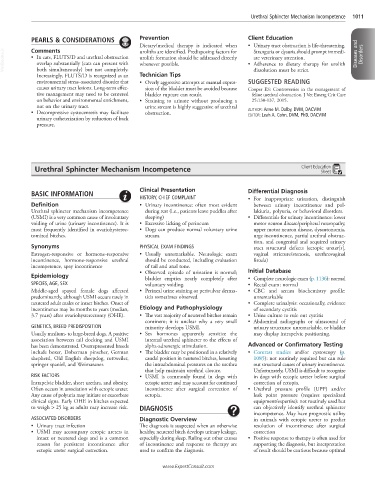Page 2019 - Cote clinical veterinary advisor dogs and cats 4th
P. 2019
Urethral Sphincter Mechanism Incompetence 1011
PEARLS & CONSIDERATIONS Prevention Client Education
Dietary/medical therapy is indicated when • Urinary tract obstruction is life-threatening.
Comments
VetBooks.ir • In cats, FLUTS/D and urethral obstruction urolith formation should be addressed directly • Adherence to dietary therapy for urolith Diseases and Disorders
Stranguria or dysuria should prompt immedi-
uroliths are identified. Predisposing factors for
ate veterinary attention.
overlap substantially (cats can present with
whenever possible.
both simultaneously) but not completely.
Increasingly, FLUTS/D is recognized as an Technician Tips dissolution must be strict.
environmental stress–associated disorder that • Overly aggressive attempts at manual expres- SUGGESTED READING
causes urinary tract lesions. Long-term effec- sion of the bladder must be avoided because Cooper ES: Controversies in the management of
tive management may need to be centered bladder rupture can result. feline urethral obstruction. J Vet Emerg Crit Care
on behavior and environmental enrichment, • Straining to urinate without producing a 25:130-137, 2015.
not on the urinary tract. urine stream is highly suggestive of urethral
• Decompressive cystocentesis may facilitate obstruction. AUTHOR: Anne M. Dalby, DVM, DACVIM
EDITOR: Leah A. Cohn, DVM, PhD, DACVIM
urinary catheterization by reduction of back
pressure.
Urethral Sphincter Mechanism Incompetence Client Education
Sheet
Clinical Presentation Differential Diagnosis
BASIC INFORMATION
HISTORY, CHIEF COMPLAINT • For inappropriate urination, distinguish
Definition • Urinary incontinence: often most evident between urinary incontinence and pol-
Urethral sphincter mechanism incompetence during rest (i.e., patients leave puddles after lakiuria, polyuria, or behavioral disorders.
(USMI) is a very common cause of involuntary sleeping) • Differentials for urinary incontinence: lower
voiding of urine (urinary incontinence). It is • Excessive licking of perineum motor neuron disease/peripheral neuropathy,
most frequently identified in ovariohysterec- • Dogs can produce normal voluntary urine upper motor neuron disease, dysautonomia,
tomized bitches. stream. urge incontinence, partial urethral obstruc-
tion, and congenital and acquired urinary
Synonyms PHYSICAL EXAM FINDINGS tract structural defects (ectopic ureter[s],
Estrogen-responsive or hormone-responsive • Usually unremarkable. Neurologic exam vaginal stricture/stenosis, urethrovaginal
incontinence, hormone-responsive urethral should be conducted, including evaluation fistula)
incompetence, spay incontinence of tail and anal tone.
• Observed episode of urination is normal; Initial Database
Epidemiology bladder empties nearly completely after • Complete neurologic exam (p. 1136): normal
SPECIES, AGE, SEX voluntary voiding. • Rectal exam: normal
Middle-aged spayed female dogs affected • Perineal urine staining or perivulvar derma- • CBC and serum biochemistry profile:
predominantly, although USMI occurs rarely in titis sometimes observed unremarkable
neutered adult males or intact bitches. Onset of • Complete urinalysis: occasionally, evidence
incontinence may be months to years (median, Etiology and Pathophysiology of secondary cystitis
3.7 years) after ovariohysterectomy (OHE). • The vast majority of neutered bitches remain • Urine culture to rule out cystitis
continent; it is unclear why a very small • Abdominal radiographs or ultrasound of
GENETICS, BREED PREDISPOSITION minority develops USMI. urinary structures: unremarkable, or bladder
Usually medium- to large-breed dogs. A positive • Sex hormones apparently sensitize the may display intrapelvic positioning.
association between tail docking and USMI internal urethral sphincter to the effects of
has been demonstrated. Overrepresented breeds alpha-adrenergic stimulation. Advanced or Confirmatory Testing
include boxer, Doberman pinscher, German • The bladder may be positioned in a relatively • Contrast studies and/or cystoscopy (p.
shepherd, Old English sheepdog, rottweiler, caudal position in neutered bitches, lessening 1085): not routinely required but can rule
springer spaniel, and Weimaraner. the intraabdominal pressures on the urethra out structural causes of urinary incontinence.
that help maintain urethral closure. Unfortunately, USMI is difficult to recognize
RISK FACTORS • USMI is commonly found in dogs with in dogs with ectopic ureter before surgical
Intrapelvic bladder, short urethra, and obesity. ectopic ureter and may account for continued correction of ectopia.
Often occurs in association with ectopic ureter. incontinence after surgical correction of • Urethral pressure profile (UPP) and/or
Any cause of polyuria may initiate or exacerbate ectopia. leak point pressure (requires specialized
clinical signs. Early OHE in bitches expected equipment/expertise): not routinely used but
to weigh > 25 kg as adults may increase risk. DIAGNOSIS can objectively identify urethral sphincter
incompetence. May have prognostic utility
ASSOCIATED DISORDERS Diagnostic Overview in animals with ectopic ureter to predict
• Urinary tract infection The diagnosis is suspected when an otherwise resolution of incontinence after surgical
• USMI may accompany ectopic ureters in healthy, neutered bitch develops urinary leakage, correction
intact or neutered dogs and is a common especially during sleep. Ruling out other causes • Positive response to therapy is often used for
reason for persistent incontinence after of incontinence and response to therapy are supporting the diagnosis, but interpretation
ectopic ureter surgical correction. used to confirm the diagnosis. of result should be cautious because optimal
www.ExpertConsult.com

